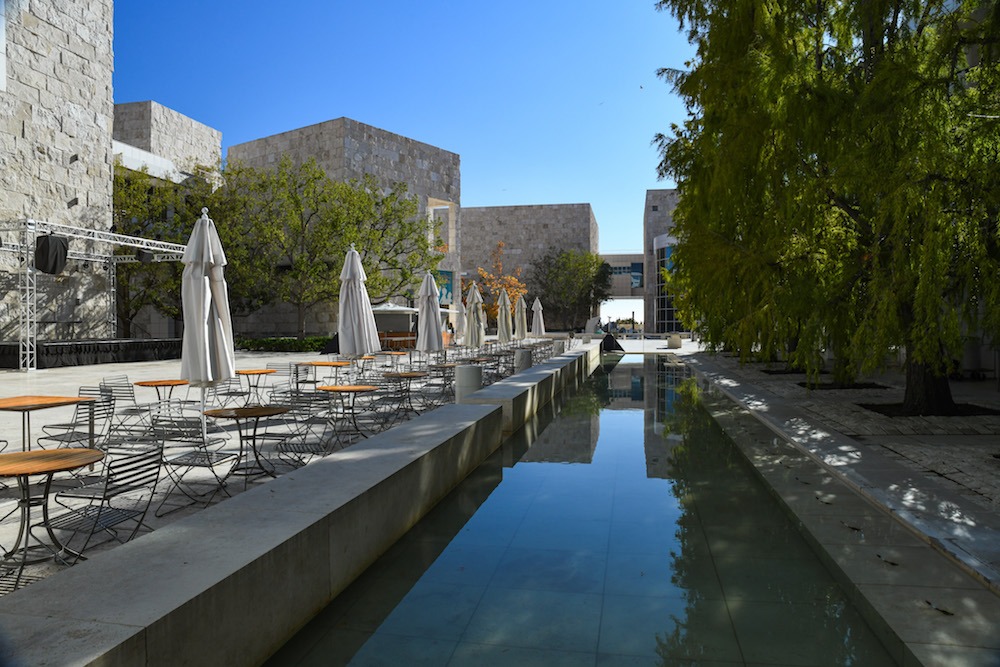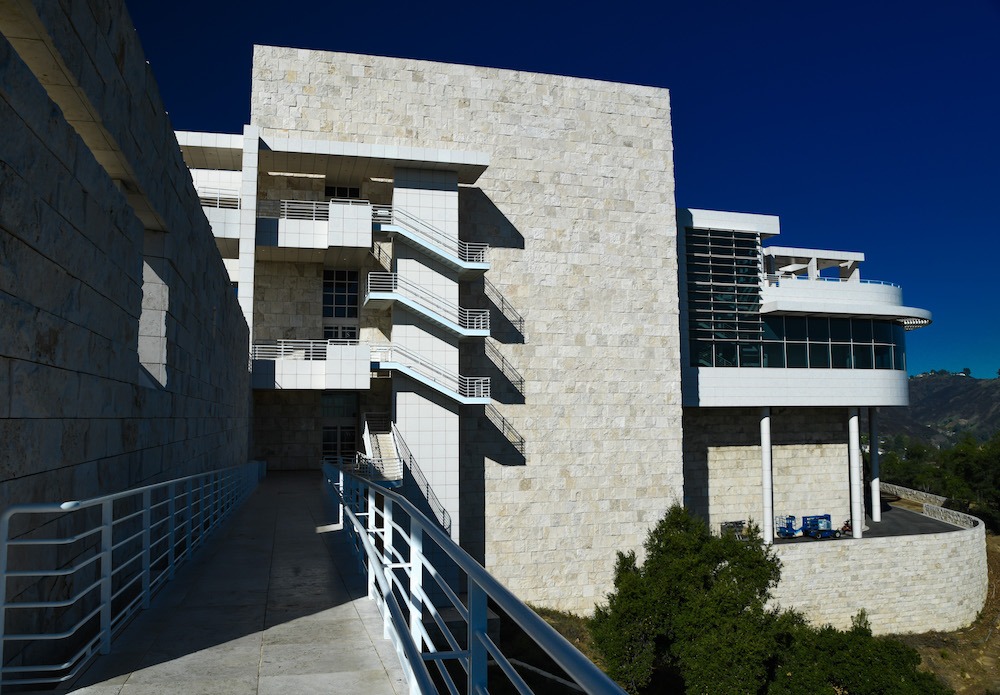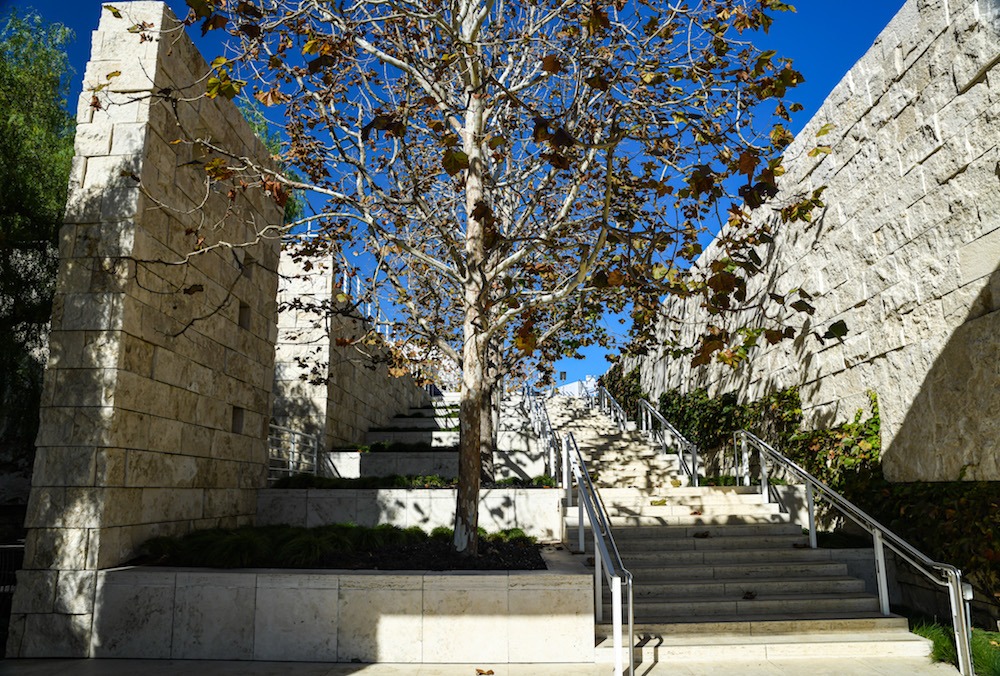J. Paul Getty Museum: An American Treasure
Words: Vanessa Salvia, Matthew Filstead, J. Getty
Words: Vanessa Salvia
Photos: Matthew Filstead
If there's anything that ignites awe, it's both a beautiful building and a museum that connects us to our past. The J. Paul Getty Museum, at the Getty Center in Los Angeles, brings visitors an extensive collection of art that spans human civilization from Greece, Rome, and the Etruscans. And the building itself inspires a sense of permanence with its facade of Italian quarried travertine.
Many of our country's historic stone buildings are right in the heart of their urban environment, where they were typically constructed as factories or offices to house the masses hard at work on building a country. Later, they might become office buildings or apartment homes, which may simply be remembered with a plaque noting the year it was built. But this American treasure, the J. Paul Getty Museum in Los Angeles, is different.
It's not in an urban core; instead, it's on a sprawling hillside where visitors must take a tram to get to it. It's not historic city property. It's located on a parcel of land intended to be developed with 35 houses by its original owner, an executive of the aerospace and defense technology company Northrop Corp. This owner sold it to the trust funding the Getty museum, the trust purchased the adjacent property from the University of California the next year, and then bought an additional 580 acres from two developers as a buffer zone. Now, the compound housing the Getty museum is an undeniable world-class gem.
Getty, The Man
While the building is remarkable, the man, J. Paul Getty, is remarkable also, and the Getty family story is even more impressive still. The "J" stands for Jean, though he was known as "Paul" his whole life. The man was born into a Scottish-American family in Minneapolis, Minnesota, on December 15, 1892. His father founded a successful oil company in Oklahoma. Within a few years, that land was producing 100,000 barrels of crude oil a month. That money eventually paved a trail leading them away from the cruel winters in Minnesota and Oklahoma to that sunny land where people with money often end up: Los Angeles, California.
Getty's young life centered around Los Angeles and Southern California, where he attended university before graduating from Oxford University in England in 1914. By August of 1915, the young Getty was already a millionaire following an investment into his father's oil company.
Shrewd investments during the Great Depression and the establishment of a large trust in the name of his mother, Sarah C. Getty, ensured the family's wealth into the future and gave the young businessman access to capital. He continued expanding the family's oil holdings in the United States and in the Middle East, and he was named the world's richest man in 1957. He married and divorced five times, producing five sons with four of his wives.

His well-known status as "the richest man in the world" proved to draw unwelcome attention to the extended Getty family, and in 1973, Getty's 16-year-old grandson, John Paul Getty III, was kidnapped and held for ransom in Italy. Although the elder Getty was a billionaire at the time, he refused to pay the demanded $17 million ransom because he believed that would put his 13 other grandchildren at risk. The kidnappers sliced off Getty the Third's right ear and sent it in the mail, leading the elder Getty to negotiate in paying $2.2 million.
As his fortune amassed, Getty began purchasing art, and his collection formed the basis of the J. Paul Getty Museum in Los Angeles. After his death in 1976, more than $661 million went to the museum.
The J. Paul Getty Museum Complexes
In 1974, Getty opened the first of his museums on his property in Malibu, California. That astounding feat re-created the Villa of the Papyri at Herculaneum (named after the discovery of a trove of scrolls), considered one of the most luxurious homes in the Roman world. In 1997, the museum moved to its current location in Los Angeles. The museum at his home property is now called the "Getty Villa" and was renovated and reopened in 2006.
What's known as "The Getty Center" was designed by Pritzker Prize-winning architect Richard Meier, currently aged 85 but still active in his firm (although he has faced some disgraceful moments as part of the #MeToo movement). The building is laid out on a hilltop in the Santa Monica Mountains, with views of Los Angeles, the Pacific Ocean, and the San Gabriel Mountains.
The Getty Center buildings are made from concrete and steel, some with aluminum cladding but most with travertine cladding. Travertine is a natural stone that is formed by the precipitation of calcium carbonate, which happens in hot springs or limestone caves. It could be considered a natural concrete in the sense that it is originally a liquid that then dries and hardens. Its qualities as a beautiful and rugged building material have been known for centuries; existing historic structures such as the Coliseum in Rome and Burghausen Castle in Bavaria are also travertine.
Italian travertine
Other than the sprawling, modern building on a gorgeous 110-acre hillside and the art inside, of course, perhaps the most remarkable thing about the building is the travertine. The stone is light beige, and catches the bright sunlight, reflecting it in a never-ending parade of shades throughout the day. The stone itself revealed fossils when quarried.

Around 1,200,000 square feet of travertine translating to 16,000 tons was used to build the Getty Center, and this gorgeous stone was quarried from Bagni di Tivoli, Italy, 15 miles east of Rome, from a quarry owned by the Mariotti family, who have been digging and cutting stone there since 1895. The Coliseum stone came from this same quarry.
Meier was said to have considered stone from all over the world—Canadian granite, Indian sandstone, French limestone and many others—including the Italian travertine, before making the decision. In an interview from 2004 with the Los Angeles Times, Meier said of the stone: "It's what we wanted from the very beginning, a distinctive look and a sense of permanence and durability."
The LA Times reported that Meier had accumulated at least 2,000 stone samples from quarries around the world by the time he met with Carlo Mariotti, who was able to both supply and cut and hone the blocks. Once the decision was made, the team was able to work with the Mariotti family for a year to invent a "guillotine" process for splitting the blocks.
The technique created the stone's rough finish and also revealed many more fossils of leaves, feathers, and shells than what was originally believed to be there. Visitors can't seem to stop themselves from tracing the fossil outlines with their fingers when they are discovered—Meier requested that these pieces be used at eye level.
If you compare travertine with other stones, it looks more crumbly and porous thanks to gaps, bubbles, grain, and inclusions. But the stone actually is much less permeable than marble, limestone, and sandstone. Although it is not as strong and impermeable as granite or basalt, it is easier to work with and more available, which translates to a lower cost.
The vertical quarry face at the quarry in Tivoli requires workers to drill holes into the stone 20 feet (6 meters) high, 40 feet (12 meters) wide, and 6 1/2 (2 meters) deep.
A diamond-studded cable is then threaded through the holes, which are attached to large pulleys. A large cut, using the diamond cables, may take a day and a half. Then the stone is pushed away and falls onto mounds of earth to cushion the fall. Then it's cut into more manageable sizes before being taken to a different location for cutting and splitting further.
In the United States, most architects use travertine as a smooth finish. Mariotti, though, insisted that the only way he would commit to the project as if the stone was used in its rough form, as it was in ancient times. Although the stone used to be quarried by hand, of course, the family has embraced technology. In this process, the slabs were rolled down a conveyor belt, then split with essentially a guillotine for the rock. The guillotine produced rough, 6-inch-thick slabs, which were further reduced to 2-inch slabs for pavers. This created two pieces with rough surfaces and smooth backs.

Up until April 2015, the Getty gift shop has continuously sold little $10 2-by-2-inch cubes of the travertine, quarried from the same Italian quarry where the building materials were originally sourced. These bits were leftover from what was shipped over to build the building, but everyone knew those pieces wouldn't last forever. Nonplussed, the team worked with a supplier of similar travertine closer to home to renew the supply, cut in a similar manner.
Glass As Masonry
One hallmark of the building is an infusion of natural light. The Getty is three stories, but nearly half of that is underground in the form of parking structures, connecting walkways, and office and workspace, due to height restrictions.
Part of Meier's brilliance was providing an infusion of natural light, even in many of these underground spaces. For the exterior walls of several of the buildings, he utilized glass neoparies, which stack like masonry blocks do. Next to the expanses of rough-cut stone, the glass looks a bit like jewelry.
Stacking the blocks
On the average, each block at the Getty Center is 2 1/2 feet square and weighs 253 1/2 pounds with a typical thickness of 3 inches. About 325,000 pieces of stone were used for facades and paving. There are also many 2 1/2-inch thick, 15-inch square panels that weigh up to 120 pounds.
Three construction techniques were used: traditional steel framing, concrete shear walls, and braced steel walls on top of the concrete walls where more height was needed. Sixty percent of the travertine panels have concrete walls behind them, with the travertine facade anchored with steel clips and expansion bolts.
The remaining 40 percent of the travertine was braced with stainless steel clips and self-tapping screws. Cranes lifted the blocks, and crewmen screwed or bolted the stones into position. Each panel is individually anchored.
The masonry contractor was DBM/Hatch Inc., of South El Monte, California, which designed and engineered the anchoring system to be able to be handset but also create a 3/8-inch open joint. DBM worked with the quarry to prepare the anchorage points based on the drawings the company created for each and every stone used in the walls and pavings—a process that took more than three years and more than 2,500 drawings.
Satisfying a demanding Brentwood neighborhood homeowners association, satisfying legal requirements, understanding geologic issues of building on a hillside prone to fires and earthquakes, and creating exacting architectural plans for a 940,000-square-foot complex that would house a world-class art collection stretching back into antiquity proved to be a complex and lengthy undertaking.
The city demanded that no dirt be removed from the site, meaning that the dirt displaced by construction needed to be moved to different points around the hill. Seven hundred and fifty workers showed up to the site each day to work on six different buildings.
Working on these buildings was not as simple as stacking Lego blocks, even though the stone may have been cut to relatively modular proportions. Each of the six buildings in the complex has a different design, including curved walls and odd angles.
Once construction began, it took nine years to complete: a million square feet of buildings, 325,000-plus travertine blocks, 25 million pounds of steel reinforcing bars. In 1993, the LA Times reported on the costs of the venture. Getty officials revealed that the estimated cost would be $733 million. But just two years prior, when Meier's plans were announced in 1991, construction costs alone were estimated at $360 million. While Getty's original trust seemed unlimited in its funds, the team actually did take steps to stay within the budget. Such as it was, the artful cutting of the travertine slabs for paving was actually a budget-cutting measure.

Protecting The Stone
The surfaces of the stones were treated with a silicate-based water repellent, and this technique adds additional protection for the surfaces over time by allowing water to drain behind the outer skin. This way, the surface is protected from streaking, and each stone can move slightly independently—a crucial factor in building to Southern California's strict earthquake standards.
Paving stone and walls in public areas up to a height of 6 1/2 feet have also been treated with an oil-resistant coating to reduce general dirt and grime buildup.
Protecting The Artwork
With an unbelievable collection of art behind its walls, the museum needed to be both earthquake-safe and fireproof. It was designed with these two factors in mind, and construction was already underway when the Northridge Quake happened in 1994. At that time, engineers were able to respond and make adjustments for structural safety. When a fire broke out in the nearby hills in October 2019, no one was worried about protecting priceless art by Rembrandt, Manet, or Van Gogh. The museum holds 125,000 objects of art and 1.4 million volumes in its library, including the world's largest collection of art books.
Antiquities such as a Greek statue from 300 years before the time of Christ are protected by interior walls built of reinforced concrete or fire-protected steel, with rooms and buildings protected by fire separations, so that doors can be closed to keep any fire from spreading. Any flat roof is also covered with crushed stone, and the landscaping itself, which features drought-resistant plants, travertine paving, and fountains, proved crucial to containing any fire that might try to engulf the building.
In October 2019, the "Getty Fire" proved to be practically a non-event for the artwork anyway. While thousands of residents were evacuated from the area, the museum had to take no action to protect the art because sprinklers in the landscaping put out the fire. Two hundred firefighters who were battling the blaze stayed at the Getty, showering, eating meals, and sleeping.
Concrete in the Getty Villa
The original Malibu property has received facelifts over the years. Getty told the LA Times in 1974 that he was opening the recreation of the luxury Herculaneum home known as The Getty Villa so that visitors could "go to Pompeii and Herculaneum and see Roman villas the way they are now—then go to Malibu and see the way they were in ancient times."
After opening in 1974, the villa closed in 1997 and underwent an extensive 5-year renovation before reopening in 2006. New buildings take advantage of decorative concrete on walls that are exposed to public view. In keeping with the Roman theme, the decorative structural elements incorporate board-forming to replicate deep wood grain.
Applying a mix onto walls allowed for exposing the aggregate in the mix by sandblasting or grinding. One feature known as the Strata Wall implies an archeological excavation. The design used layers of wood, bronze, stone, and concrete to mimic a naturally occurring stratum.
In 2018, the villa underwent small renovations, including 3,000 square feet, more exhibition space spread across 33 galleries.

Dedicated to The City
When the museum opened on December 16, 1997, after approaching the $1 billion mark in costs, the world had not seen anything like it. The opening of the Getty turned Los Angeles into an art center. It turned the eyes of the city toward an idea of something approaching permanence, which, in this town of glitz and glamour that was constantly reinventing itself, was something remarkable that was completely separate from the art it brought to the public.
If the museum has faced any real criticism, it's been because of its "castle on the hill" perception; it's detached from the city where actual Angelenos live, and parking is so difficult that visitors must make reservations to have a place for their car. But, the building is a massive undertaking of scale and complexity, which seems befitting its complicated, successful yet penny-pinching namesake. And while the sun, the palm trees, the beach, and celebrities have long been what Los Angeles is known for, the Getty gave the city a new gem to be proud of.
On December 14, two days before its public opening, architect Meier said he meant his building to lay to rest the image of Los Angeles as a "place that used to exemplify the transitory." Instead, Meier said, the Getty represented, "permanence, rootedness, and accessibility," which it surely will for generations to come.